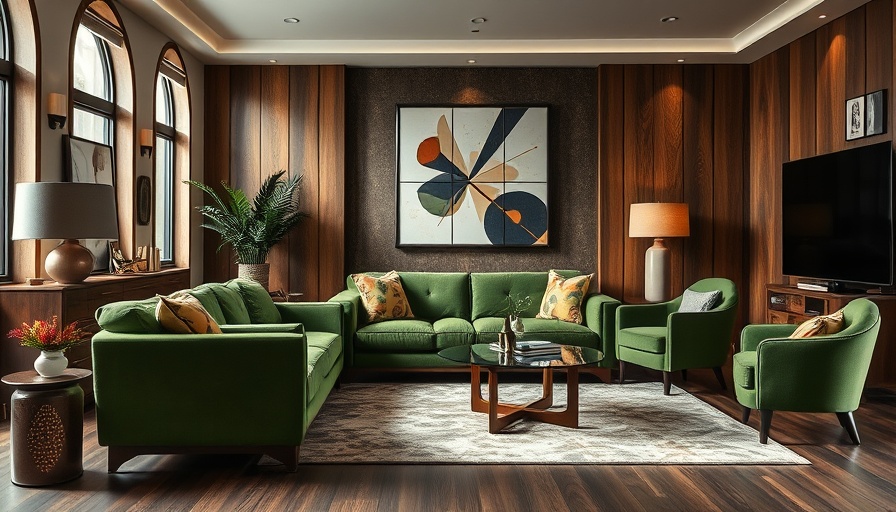
Reviving a Classic: What Is Art Deco Design?
Art Deco design is a visual feast of style and elegance, rooted in balance, symmetry, and bold expression. As Brent Hunter from ArchiNerd puts it, it’s about “drawing from diverse inspirations” to create spaces that feel cohesive and full of character. This design movement, which flourished in the 1920s and 30s, channels an era of glamour reminiscent of grand hotels in Paris and the stylistic opulence of Miami's architecture. With the right approach, homeowners and renters can effortlessly evoke the spirit of this iconic era throughout their living spaces.
1. Bold Geometry Complements Any Space
When integrating Art Deco into your home, think about introducing bold geometric shapes and vibrant colors. Sheeja Nair, owner of Raashi Design, emphasizes the importance of statement pieces: “For renters, consider mirrors in striking geometric designs or vibrant velvet throw pillows that reflect deep jewel tones.” These elements channel the essence of Art Deco without requiring permanent changes, making them ideal for both homeowners and renters.
2. Art That Speaks
Art Deco is synonymous with striking visuals, and wall art is the perfect medium to express this. Consider anchoring your living room with large geometric paintings or a series of prints with metallic accents. According to Desislava Spasova from Singulart, these choices immediately capture the elegance of the Art Deco style—without any need for structural renovations—making it simple to make a grand statement.
3. Patterns that Pop
Patterns are central to Art Deco's charm. Homeowners can easily adopt this style by introducing bold patterns into their spaces. Lauren Lerner, CEO of Living With Lolo, suggests using geometric wallpaper or graphic throw pillows to introduce vibrancy. For those in rental apartments, peel-and-stick wallpaper can be an affordable and temporary solution to achieve this aesthetic.
4. Textured Elegance
The luxurious feel of textures is a hallmark of Art Deco design. Consider layering diverse fabrics like velvet or silk. A plush velvet sofa paired with a marble coffee table can create an inviting focal point that exudes sophistication and charm. Textures can soften the bold structures often found in Art Deco designs, balancing practicality with high fashion.
5. Lighting that Dazzles
Lighting plays a crucial role in establishing ambiance. Art Deco lighting often features sculptural fixtures that serve as conversation starters. Think about a striking chandelier or a sculptural lamp to illuminate your space while also complementing the bold shapes found throughout your decor. This combination of functionality and artistry is quintessential to the Art Deco ethos.
6. Mix Old and New Influences
Don't shy away from mixing contemporary elements with your Art Deco pieces. This contrast can create a layered effect that feels both fresh and timeless. The combination of a sleek modern chair with a vintage Art Deco table can showcase eclectic tastes that evoke narrative and character. This balance between old and contemporary can help define your personal style in a way that feels curated rather than contrived.
7. Color Schemes that Captivate
Art Deco color palettes are typically bold yet refined. Shades of deep blue, emerald green, and rich burgundy lend drama and sophistication. Metallic accents can also enhance any color scheme, adding a sense of luxe to a room. Selecting a limited palette that embodies these hues can help streamline the design process and ensure cohesion throughout your space.
8. Incorporating Architectural Elements
If you have the freedom to make permanent changes, consider architectural elements typical of Art Deco design. Think curved doorways, stepped forms, and patterned moldings. While you may not be able to undergo a complete home renovation, small investments in architectural details can bring significant enhancement to any space.
9. Incorporating Furniture with Flair
Furniture plays a key role in establishing the overall vibe of your space. Choose pieces that reflect Art Deco’s elegance—think curved sofas, plush upholstered chairs, or bold accent tables with geometric designs. These selections will not only elevate the aesthetics of your home, but they will also provide functionality while staying true to the Art Deco theme.
10. Personal Style Meets Historical Influence
The ultimate goal of adopting Art Deco in your home is to create a space that is uniquely yours while being culturally and aesthetically rich. Each curated piece tells a story of artistry and history, bringing a sense of elegance and charm. Your home should resonate with your personal style while also celebrating the grandeur of Art Deco.
Whether you’re looking to revamp your home decor or simply sprinkle in some Art Deco flair, there’s a wealth of opportunity with this timeless aesthetic. Enrich your space and tell your design story today!
 Add Row
Add Row  Add
Add 



Write A Comment